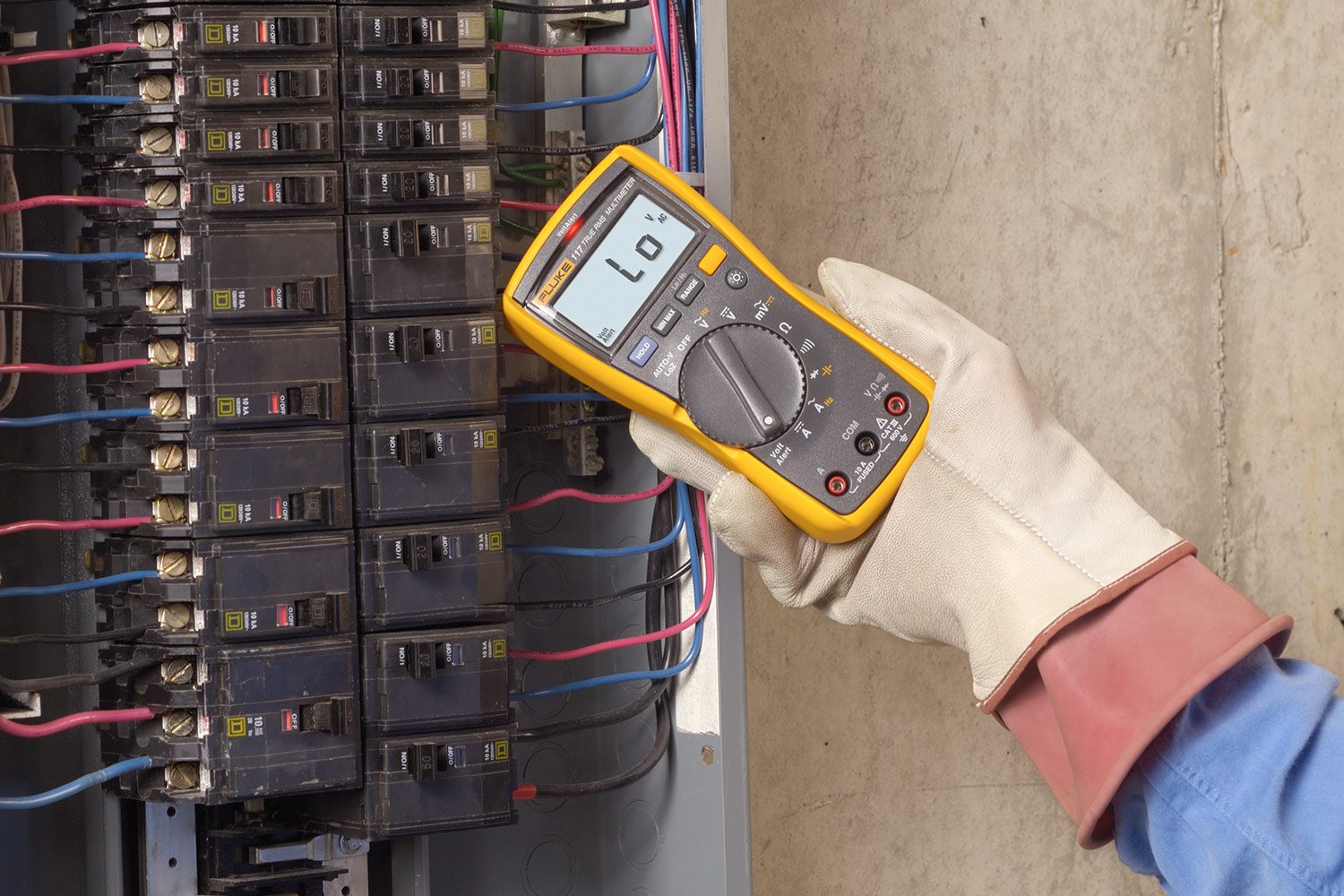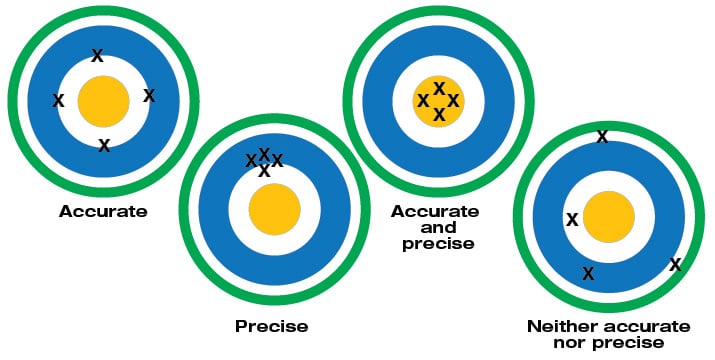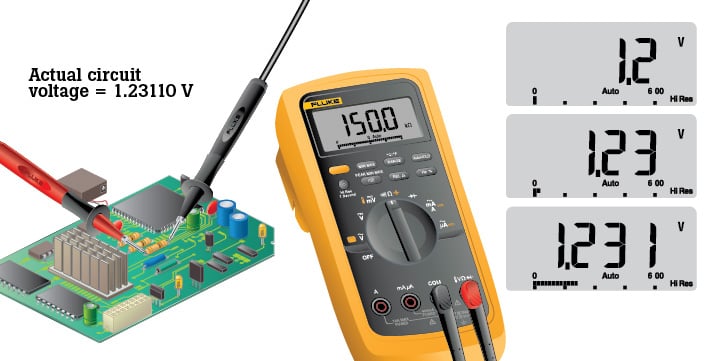- Qu´est-ce que l´exactitude d´un multimètre numérique ?
- Comment les multimètres numériques fournissent-ils des relevés cohérents ?
- Qu´entend-on par résolution dans la mesure ?
- Qu´est-ce que la plage d´un multimètre ?
- Quelle est la différence entre points et chiffres ?
Il est important d´utiliser un multimètre qui fournit les bonnes mesures. Il est encore plus important de connaître la signification de ces mesures. L´exactitude et la précision garantissent que les mesures que vous prenez seront utiles. Une meilleure précision facilite la répétabilité et une meilleure exactitude signifie que vos mesures seront plus proches de la perfection.

Qu´est-ce que l´exactitude d´un multimètre numérique ?
L´exactitude fait référence à la plus grande marge d´erreur autorisée se produisant dans des conditions de fonctionnement spécifiques. Elle est exprimée en pourcentage et indique la proximité de la mesure affichée avec la valeur réelle (standard) du signal mesuré. L´exactitude requiert une comparaison avec une norme industrielle acceptée.
L´exactitude d´un multimètre numérique spécifique est importante selon l´application. Par exemple, la plupart des tensions d´alimentation AC peuvent varier de ±5 % ou plus. Un exemple de cette variation est une mesure de tension prise sur une prise standard de 115 VAC. Si vous utilisez un multimètre numérique uniquement pour vérifier si une prise est sous tension, un multimètre numérique avec ±3 % d´exactitude de mesure est approprié.
Certaines applications, comme l´étalonnage d´équipement industriel spécialisé dans les secteurs automobile, médical et aéronautique peuvent nécessiter une exactitude plus élevée. Un relevé de 100,0 V sur un multimètre numérique avec une exactitude de ±2 % peut varier de 98,0 V à 102,0 V. Ceci peut être satisfaisant pour certaines applications mais inacceptable pour des équipements électroniques sensibles.
L´exactitude peut également inclure une quantité spécifiée de chiffres (points) ajoutés à la valeur de base de l´exactitude. Par exemple, une exactitude de ±(2 % + 2) signifie qu´un relevé de 100,0 V sur le multimètre peut être compris entre 97,8 V et 102,2 V. L´utilisation d´un multimètre numérique doté d´une meilleure exactitude permet un grand nombre d´applications.
L´exactitude DC de base des multimètres numériques portables Fluke est comprise entre 0,5 % et 0,025 %.

Quel est le degré de précision d´un multimètre numérique ?
La précision fait référence à la capacité d´un multimètre numérique à fournir la même mesure à plusieurs reprises.
Un exemple courant utilisé pour expliquer la précision est la disposition des trous effectués sur une cible d´un stand de tir. Cet exemple suppose qu´un fusil est dirigé vers le centre de la cible et que le tir est effectué depuis la même position à chaque fois.
Si les trous sont regroupés mais en dehors du centre de la cible, le fusil (ou le tireur) peut être considéré comme précis mais pas exact.
Si les trous sont regroupés dans le centre de la cible, le fusil est à la fois précis et exact. Si les trous sont répartis de manière aléatoire sur toute la cible, ce n´est ni précis ni exact (ni reproductible).
Dans certaines circonstances, la précision, ou répétabilité, est plus importante que l´exactitude. Si les mesures sont répétables, il est possible de déterminer un modèle d´erreur et de le compenser.
Qu´entend-on par résolution dans la mesure ?
La résolution est le plus petit incrément qu´un outil peut détecter et afficher.
Pour donner un exemple non électrique, prenons l´exemple de deux règles. Une règle marquée de hachures de 1/16 pouces offre une plus grande résolution qu´une règle marquée de hachures d´un quart de pouce.
Imaginons un simple test sur une pile ordinaire de 1,5 V. Si un multimètre numérique a une résolution de 1 mV sur la plage 3 V, il est possible de voir un changement de 1 mV pendant la lecture de la tension. L´utilisateur peut voir des variations aussi faibles qu´un millième de volt ou 0,001 sur la plage 3 V.
La résolution peut être indiquée dans les spécifications d´un multimètre en tant que résolution maximale, qui est la plus petite valeur qu´il est possible de discerner sur le réglage de plage le plus bas.
Par exemple, une résolution maximale de 100 mV (0,1 V) signifie que lorsque la plage du multimètre est réglée pour mesurer la tension la plus élevée possible, la tension s´affiche au dixième de volt près.
La résolution est améliorée en réduisant le réglage de la plage du multimètre numérique, à condition que la mesure se trouve dans la plage définie.

Qu´est-ce que la plage d´un multimètre ?
La plage et la résolution d´un multimètre numérique sont liées et sont quelquefois précisées dans les spécifications du multimètre numérique.
De nombreux multimètres offrent une fonction de plage automatique qui sélectionne automatiquement la plage appropriée pour l´amplitude de la mesure effectuée. Ceci permet un relevé significatif ainsi que la meilleure résolution pour une mesure.
Si la mesure est supérieure à la plage définie, le multimètre affiche OL (surcharge). La mesure la plus précise est obtenue au réglage le plus bas possible de la plage sans surcharge du multimètre.
| Plage et résolution | |
| Plage | Résolution |
| 300,0 mV | 0,1 mV (0,0001 V) |
| 3,000 V | 1 mV (0,001 V) |
| 30,00 V | 10 mV (0,01 V) |
| 300,0 V | 100 mV (0,1 V) |
| 1 000 V | 1 000 mV (1 V) |
Quelle est la différence entre points et chiffres ?

Les points et les chiffres sont des termes utilisés pour décrire la résolution d´un multimètre numérique. Aujourd´hui, il est plus courant de classer les multimètres numériques par nombre total de points que par chiffres.
Points : La résolution d´un multimètre numérique est également spécifiée en points. Un nombre de points plus élevé offre une meilleure résolution pour certaines mesures. Par exemple, un multimètre à 1 999 points ne peut pas mesurer jusqu´à un dixième de volt si la mesure est de 200 V ou plus. Fluke propose des multimètres numériques à 3½ chiffres avec un nombre de points allant jusqu´à 6 000 (ce qui signifie un maximum de 5 999 sur l´écran du multimètre) et des multimètres à 4½ chiffres avec un nombre de points de 20 000 ou 50 000.
Chiffres : La gamme de produits Fluke comprend des multimètres numériques à 3½ et 4½ chiffres. Par exemple, un multimètre numérique à 3½ chiffres peut afficher trois chiffres complets et un demi-chiffre. Les trois chiffres complets affichent un nombre compris entre 0 et 9. Le demi-chiffre, considéré comme le chiffre le plus significatif, affiche un 1 ou reste vide. Un multimètre numérique à 4½ chiffres peut afficher quatre chiffres complets et un demi-chiffre, ce qui signifie qu´il a une résolution plus élevée qu´un multimètre à 3½ chiffres.